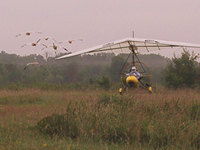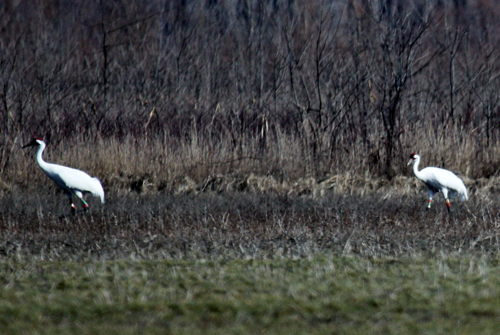|
Meet
the 2009 Whooping Crane Chicks!
Hatch-year 2009 of the Eastern Flock |
||||||||||||||
|
Crane
# 907 (7-09)
|
||||||||||||||
|
Date Hatched |
May 7, 2009 |
|||||||||||||
|
Gender |
Female |
|||||||||||||
|
Egg Source |
Patuxent WRC |
|||||||||||||
Permanent (Attached after reaching Florida)
|
*Colors changed in 2015 from R/G to RGW |
|||||||||||||
|
||||||||||||||
Personality,
Early Training
Notes from
the captive breeding "hatchery" at Patuxent WRC
in Maryland:
 |
Brooke
and the "robo-crane" puppet give #907 a mealworm treats
during a training break. Photo Operation Migration |
On the first trips outside with other little chicks, the costumes/trainers learned early that 907 always lagged behind. Then she stuck out her little stubby wings and ran as fast as she could to catch up. It will be fun to see how she changes as she grows. Here's a photo of her doing circle pen training as she learns to walk near the ultralight.
She was grouped for socializing with 905, 906, and 908. She had always been a very submissive chick but in mid June, 907 decided that should change. She walked through the pen one afternoon taking pecks and jabs at anyone close by. Except for 908, the other birds just moved out of her way. But usually aggressive 908 stood up to 907. The two girls faced off and each pecked at the other's beak, and #907 got the better of #908 — who skulked off with head lowered and one wing out in the most submissive posture a chick can take. It sounds like #907 is coming up in the ranks!
 |
Cohort
1 FLYING Aug. 17 Photo Bev Paulan, Operation Migration
|
Notes of
Flight School in Wisconsin:
She was
flown to Wisconsin with Cohort #1 chicks on June 25. When they were
finally led into their new pen, the tired 907 took a nap. That was
unusual, as she's usually a worrier. when she awoke, she seemed
right at home! Most of the chicks pecked at their new leg bands or even
the bands of other chicks.
She did well in training sessions as the wing was added to the trike and the chicks first steps in flight attempts proceded. Like all the chicks in cohort one, she was flying by July 20. By early August cohort one was flying circles over the training areas. By mid-August they were flying larger and longer circuits and doing well as a "team."
Geoff says crane #907 seems timid and wary. She backs away from the handlers. She minds her own business and is reliable in training.
| First Migration South: Chick #907 (and 14 others!) turned back to Necedah NWR when the Class of 2009 left on their first migration on October 16, 2009. They all had to try again the next day to follow the ultralights to the migration's first stopover site, where five of their flockmates landed on Day 1. Find day-by-day news about the flock's migration and read more about #907 below. | |
| Oct. 20 (Still trying to reach Stopover #1): Today #907 did a great flight! She was the ONLY one of the 9 chicks still at their old Necedah pen who would follow pilot Joe today. After another crane rodeo in the air, 8 are still at Necedah but #907's arrival makes 12 now at Stopover #1 on a day when the pilots had hoped and planned to fly all 20 birds onward to Stopover #2. DAY ONE drags on to more days! | |
Oct. 27: Crane# 907 turned back to old Stopover #1 on today's flight. She (and several others!) had to be boxed and driven to Stopover #2. Nov. 1: Hooray! 907 (and ALL the others!) flew the distance to Stopover #3. No crates needed! |
|
Nov. 20: Crane 907 was one of ony four chicks who obediently came back when called on exercise day. The other 16 took off and didn't come back! The next day, the obedient four followed the ultralight to join their flock mates at Stopover #7. January 20, 2010, Day 89: Migration complete for the "Chass 10:" #901, 903, 904, 905, 907, 913, 919, 924, 927, and 929! Female 907 flew all but 18 miles of this migration! |
|
 |
Four days after arrival at Chass, the chicks got health checks and their new bands. This photo shows 907's new bands. The radio transmitter is on the left and the satellite transmitter (PTT) is on the right. Photo by ICF tracker Eva.
 |
What
is missing from 907's leg? Find
out. Photo Matt Strausser, ICF |
March 13: The chicks at Chass with adult pair #105and #501were beginning to show signs of migration restlessness. Eva said, "It was a windy night and they continued to fly around, land, fly around, land, fly around, land…well, you get the picture. This is typical behavior for the chicks before they decide to head back north. Although it would be a little on the early side for them to be leaving this week, we are not sure if the adult pair will entice the chicks to leave earlier than they would otherwise."
Spring 2010, First Journey North: The "Chass 9" crane kids (901, 904, 905, 907, 913, 919, 924, 927 and 929) began migration on April 5 at 10:00 a.m. With them were subadults 824, 827 and 830. While they did not remain in one group for the whole flight, they all ended up landing together in Grady County, Georgia around 6:00 p.m their first day of migration. The next morning, Apr. 6, female 907 apparently split from the group early in the morning and flew to a different location somewhere to the north. She was also continuing her migration, but this time alone. Tracker Eva reported that 907 roosted in Etowah County, Alabama on the night of April 6; in Todd County, Kentucky on the nights of April 7 and 8; in Warrick County, Indiana, on the night of April 9th; Kankakee County, Illinois, on the night of April 10th; and at Will County, Illinois, on the night of April 11 for several more days. On April 12 Eva reported that 907 is traveling alone, not with sandhills. "April 12 was a perfect migration day there, but she was apparently not interested in leaving even though she's a day's flight from Necedah NWR." She resumed migration May 16 and roosted that night in Dane County, Wisconsin. By May 18 she had moved to Horicon NWR in Dodge County, where she stayed before completing migration to Necedah NWR on May 29—this time with #36-09 DAR. In typical subadult behavior, she wandered in several counties, including Dodge, Fond du Lac, Waushara, Green Lake and Adams Counties, sometimes joining other Whooping or Sandhill cranes during the summer.
Fall 2010: Numbers herafter switch from the naming conventions of OM to those of WCEP: Cranes #7-09 (#907), #5-09 (905), 42-09 DAR and #33-07 (#733) were reported in Shelby County, Alabama, on December 8. Tracker Eva discovered the group again on January 28, 2011. "They are at #33-07's (733')s previous wintering territory from two winters ago down in Polk County, Florida," noted Eva. "This was the first time that area had been checked this winter, so they have probably been there for quite some time."
Spring 2011: Female #7-09 (#907) and cranes #17-03 (#733) and #5-09 (905) and 42-09 DAR were reported in LaSalle County, Illinois, on March 24 and resumed migration from this location on March 30. They were found at their previous summering territory in Adams County, Wisconsin, on April 4, migration complete!
Fall 2011: Migrated only as far as Lawrence County, Illinois.
Spring 2012: Female #7-09 (#907) arrived on the nesting grounds of Necedah NWR in Wisconsin on March 7 with male #17-03 (#317), whose mate died last August. This new pair was observed sitting on a nesting platform in May, but were not observed there again. No eggs were ever confirmed but perhaps next year they'll become parents!
Fall 2012: Female #7-09 (#907) wintered with her mate #17-03 first in Lawrence County, IL (their previous wintering location) before the pair moved to Knox County, Indiana, for the remainder or the winter. They began their journey north to Wisconsin on March 22 or 23.
Spring 2013: Female #7-09 (#907) arrived March 29 on the nesting grounds of Necedah NWR in Wisconsin with her mate, #17-03 (#317). They soon had a nest together but the nest faied early in May, along with the nests of several other crane pairs during an outbreak of black flies. This pair did not attempt to renest this summer.
Fall 2013: migrated to Knox County, Indiana, apparently re-paired with male #12-05. "We do not know what happened to her previous mate, #17-03, but it's possible that #12-05 stole 7-09 away from him," said ICF tracker Eva Szyszkoski. The pair remained in Knox County as of January 31 but later broke up.
Spring 2014: Female #7-09 completed migration to the Necedah NWR by 28 March when she was observed with a crane with a nonfunctional transmitter. She has since been observed with a new mate, male #26-10 DAR. (Crane #12-05, her "mate" during the winter, was on his remote territory, also with a new mate.)
Fall 2014: Female #7-09 began migration from the Necedah area with mate #26-10 DAR on November 16 and wintered in Gibson County, Indiana along with 16-04.
Spring 2015: Female #7-09 returned with mate #26-10 DAR and the pair had an active nest by May 4, but no further updates about any successful hatchings.
Fall 2015: Female #7-09 migrated from the Necedah area to Lawrence County, Illinois.
Spring 2016: She was photographed in February 2016 on her wintering grounds with a new mate, male #10-11. Crane #7-09 has also had a band color change (see above). Sad news came on March 12 when her body was discovered in Lawrence County, Illinois. Cause of death was undetermined. Her mate #10-11 was alive nearby.

Image: Pete Weber
Last updated: 3/13/16
Back to "Meet the Flock 2009"

